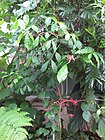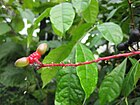Note: This is a project under development. The articles on this wiki are just being initiated and broadly incomplete. You can Help creating new pages.
Difference between revisions of "Quassia amara - Bitter wood"
(→Photo Gallery) |
|||
| (15 intermediate revisions by 2 users not shown) | |||
| Line 1: | Line 1: | ||
| − | |||
| − | |||
[[File:Quassia amara12.JPG|thumb|right|''Quassia amara'']] | [[File:Quassia amara12.JPG|thumb|right|''Quassia amara'']] | ||
| − | + | '''Quassia amara''' ('''Amargo, Bitter-ash, Bitter-wood''') is a species in the genus Quassia, with some botanists treating it as the sole species in the genus. The genus was named by Carl Linnaeus who named it after the first botanist to describe it. It is used in traditional medicine and as additive in the food industry. | |
| − | '''Quassia amara''' (''' | ||
| − | |||
==Uses== | ==Uses== | ||
| − | {{Uses| | + | {{Uses|Intestinal parasites}}, {{Uses|Skin parasites}}, {{Uses|Intestinal parasites}}, {{Uses|Amebic infections}}, {{Uses|Malaria}}, {{Uses|Digestive problems}}, {{Uses|Eliminate toxins}}, {{Uses|Liver problems}}. |
==Parts Used== | ==Parts Used== | ||
| − | {{Parts Used| | + | {{Parts Used|Wood}}, {{Parts Used|Leaves}}. |
==Chemical Composition== | ==Chemical Composition== | ||
| − | The main chemicals identified in amargo include: beta-carbolines, beta-sitostenone, beta-sitosterol, dehydroquassins, gallic acid, gentisic acid, hydroxyquassins, isoparain<ref name="chemical composition"/> | + | The main chemicals identified in amargo include: beta-carbolines, beta-sitostenone, beta-sitosterol, dehydroquassins, gallic acid, gentisic acid, hydroxyquassins, isoparain/.<ref name="chemical composition"/> |
==Common names== | ==Common names== | ||
| − | {{Common names|kn=|ml= | + | {{Common names|kn=|ml=|sa=|ta=|te=|hi=|en=}} |
==Habit== | ==Habit== | ||
| − | {{Habit| | + | {{Habit|Shrub}} |
==Identification== | ==Identification== | ||
===Leaf=== | ===Leaf=== | ||
| − | {{Leaf| | + | {{Leaf|Simple|Alternate, Pinnate|Native to Brazil, Bitter Quassia ia a small forest tree, typically with a leaning stem, sometimes multiply-stemmed.}}<ref name="Leaf"/> |
===Flower=== | ===Flower=== | ||
| − | {{Flower|Unisexual|15-25 cm long| | + | {{Flower|Unisexual|15-25 cm long|White||The flowers are produced in a panicle 15-25 cm long, each flower 2.5-3.5 cm long, bright red on the outside, and white inside. They are tubes with a narrow mouth, somewhat wider at the base}} |
===Fruit=== | ===Fruit=== | ||
| − | {{Fruit|||Syncarp (sorosis) The fruit consists of 4-5 berries held together in a red receptacle | + | {{Fruit|||Syncarp (sorosis) The fruit consists of 4-5 berries held together in a red receptacle.|Ovoid|Many}} |
===Other features=== | ===Other features=== | ||
==List of Ayurvedic medicine in which the herb is used== | ==List of Ayurvedic medicine in which the herb is used== | ||
| − | |||
==Where to get the saplings== | ==Where to get the saplings== | ||
| Line 43: | Line 38: | ||
==Commonly seen growing in areas== | ==Commonly seen growing in areas== | ||
| − | {{Commonly seen|Tropical}}, {{Commonly seen| | + | {{Commonly seen|Tropical area}}, {{Commonly seen|Subtropical area}}, {{Commonly seen|Monsoonal area}}. |
==Photo Gallery== | ==Photo Gallery== | ||
<gallery class="left" caption="" widths="140px" heights="140px"> | <gallery class="left" caption="" widths="140px" heights="140px"> | ||
| − | |||
| − | |||
| − | |||
| − | |||
| − | |||
| − | |||
Bitter wood (Quassia amara) 3.jpg | Bitter wood (Quassia amara) 3.jpg | ||
| − | |||
| − | |||
Bitter wood (Quassia amara).jpg | Bitter wood (Quassia amara).jpg | ||
| − | |||
| − | |||
Flower Quassia amara.JPG | Flower Quassia amara.JPG | ||
| − | |||
| − | |||
Gardenology-IMG 7914 hunt10aug.jpg | Gardenology-IMG 7914 hunt10aug.jpg | ||
| − | |||
| − | |||
Gardenology-IMG 7915 hunt10aug.jpg | Gardenology-IMG 7915 hunt10aug.jpg | ||
| − | |||
| − | |||
Gardenology-IMG 7916 hunt10aug.jpg | Gardenology-IMG 7916 hunt10aug.jpg | ||
| − | |||
| − | |||
Gardenology-IMG 7917 hunt10aug.jpg | Gardenology-IMG 7917 hunt10aug.jpg | ||
| − | |||
| − | |||
Gardenology.org-IMG 2043 hunt08sep.jpg | Gardenology.org-IMG 2043 hunt08sep.jpg | ||
| − | |||
</gallery> | </gallery> | ||
| Line 81: | Line 55: | ||
<references> | <references> | ||
| − | <ref name="chemical composition">[https://web.archive.org/web/20121220110825/http://rainforest-database.com/plants/amargo.htm | + | <ref name="chemical composition">[https://web.archive.org/web/20121220110825/http://rainforest-database.com/plants/amargo.htm Wayback machine]</ref> |
| − | <ref name="Leaf">[http://www.flowersofindia.net/catalog/slides/Bitter%20Quassia.html | + | <ref name="Leaf">[http://www.flowersofindia.net/catalog/slides/Bitter%20Quassia.html Morphology]</ref> |
</references> | </references> | ||
==External Links== | ==External Links== | ||
| − | + | * [http://tropical.theferns.info/viewtropical.php?id=Quassia+amara Bitter wood on tropical herbs.info] | |
| − | + | * [https://www.drugs.com/npp/quassia.html Bitter wood on drugs.com] | |
| − | + | * [https://pfaf.org/user/Plant.aspx?LatinName=Quassia+amara Bitter wood on pfaf.org] | |
| − | + | * [https://florafaunaweb.nparks.gov.sg/special-pages/plant-detail.aspx?id=2380 Bitter wood on florafaunaweb.nparks.gov] | |
[[Category:Herbs]] | [[Category:Herbs]] | ||
| + | [[Category:Simaroubaceae]] | ||
Latest revision as of 16:20, 23 July 2020
Quassia amara (Amargo, Bitter-ash, Bitter-wood) is a species in the genus Quassia, with some botanists treating it as the sole species in the genus. The genus was named by Carl Linnaeus who named it after the first botanist to describe it. It is used in traditional medicine and as additive in the food industry.
Contents
Uses
Intestinal parasites, Skin parasites, Intestinal parasites, Amebic infections, Malaria, Digestive problems, Eliminate toxins, Liver problems.
Parts Used
Chemical Composition
The main chemicals identified in amargo include: beta-carbolines, beta-sitostenone, beta-sitosterol, dehydroquassins, gallic acid, gentisic acid, hydroxyquassins, isoparain/.[1]
Common names
| Language | Common name |
|---|---|
| Kannada | |
| Hindi | |
| Malayalam | |
| Tamil | |
| Telugu | |
| Marathi | NA |
| Gujarathi | NA |
| Punjabi | NA |
| Kashmiri | NA |
| Sanskrit | |
| English |
Habit
Identification
Leaf
| Kind | Shape | Feature |
|---|---|---|
| Simple | Alternate, Pinnate | Native to Brazil, Bitter Quassia ia a small forest tree, typically with a leaning stem, sometimes multiply-stemmed. |
Flower
| Type | Size | Color and composition | Stamen | More information |
|---|---|---|---|---|
| Unisexual | 15-25 cm long | White | The flowers are produced in a panicle 15-25 cm long, each flower 2.5-3.5 cm long, bright red on the outside, and white inside. They are tubes with a narrow mouth, somewhat wider at the base |
Fruit
| Type | Size | Mass | Appearance | Seeds | More information |
|---|---|---|---|---|---|
| Syncarp (sorosis) The fruit consists of 4-5 berries held together in a red receptacle. | Ovoid | Many | {{{6}}} |
Other features
List of Ayurvedic medicine in which the herb is used
Where to get the saplings
Mode of Propagation
How to plant/cultivate
Seeds and cuttings can be used for propagation of Q. amara. Frost is not tolerated, but the plant is partially drought tolerant. A large amount of indirect light is recommended.
Commonly seen growing in areas
Tropical area, Subtropical area, Monsoonal area.
Photo Gallery
References
External Links
- Ayurvedic Herbs known to be helpful to treat Intestinal parasites
- Ayurvedic Herbs known to be helpful to treat Skin parasites
- Ayurvedic Herbs known to be helpful to treat Amebic infections
- Ayurvedic Herbs known to be helpful to treat Malaria
- Ayurvedic Herbs known to be helpful to treat Digestive problems
- Ayurvedic Herbs known to be helpful to treat Eliminate toxins
- Ayurvedic Herbs known to be helpful to treat Liver problems
- Herbs with Wood used in medicine
- Herbs with Leaves used in medicine
- Habit - Shrub
- Index of Plants which can be propagated by Seeds
- Index of Plants which can be propagated by Cuttings
- Herbs that are commonly seen in the region of Tropical area
- Herbs that are commonly seen in the region of Subtropical area
- Herbs that are commonly seen in the region of Monsoonal area
- Herbs
- Simaroubaceae








